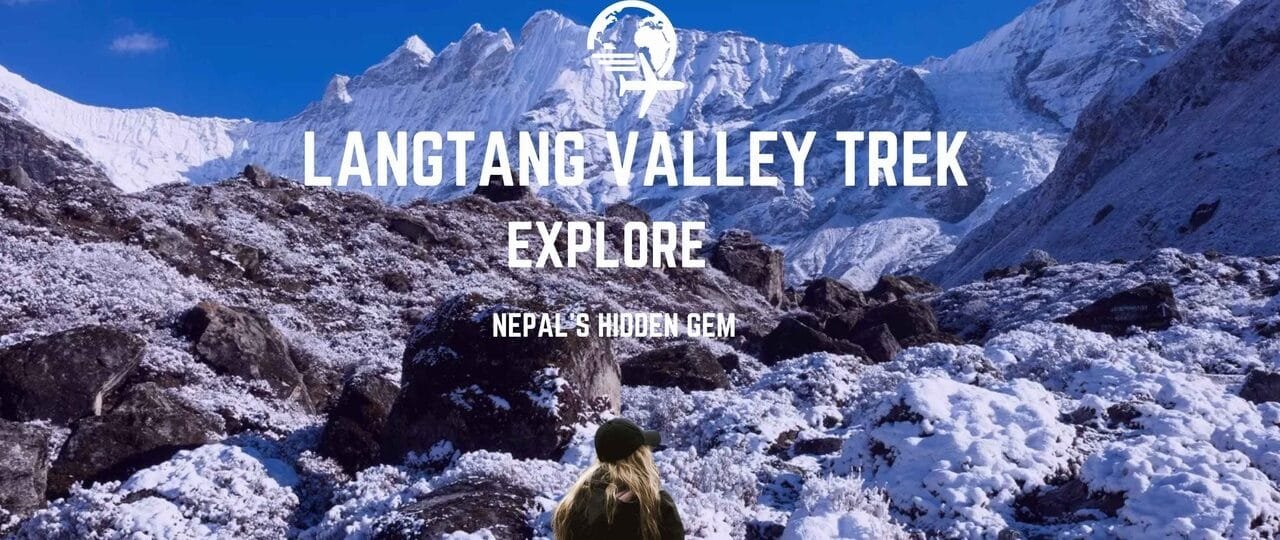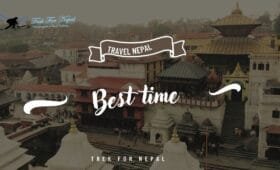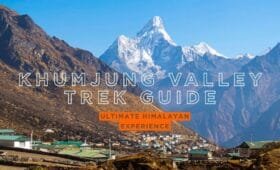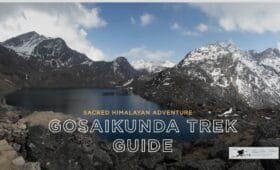The Langtang Valley Trek stands out among Nepal’s mountain adventures for its blend of cultural immersion, moderate altitude, and relatively short distance from Kathmandu. Often referred to as the “valley of glaciers,” this region features panoramic views, tranquil forests, and a vibrant Tamang community rich in Tibetan traditions. For many, the Langtang Trek provides a less-crowded alternative to routes like Annapurna or Everest. At the same time, it offers an equally rewarding journey with lush rhododendron trails, stunning peaks, and welcoming local hospitality.
In this in-depth guide, we’ll discuss everything from the essentials of Langtang Valley Trekking — such as the Langtang Valley Trek Itinerary, Langtang Valley Trek Cost, and suitable Langtang Valley Trek Packages—to practicalities like the Langtang Valley Trek Map, how to assess Langtang Valley Trek Difficulty, the must-have Langtang Valley Trek Permits, and the recommended gear. You’ll also learn about the best times to go, how to prepare physically, and tips for securing the ideal Langtang Valley Trek Guide. If you’re seeking a balanced Himalayan trek rich in culture and natural wonders, the Langtang Valley Trek is your calling.
1. Introduction: Why the Langtang Valley Trek?
Situated just north of Kathmandu, Nepal’s more famous treks in Annapurna or Everest often overshadow the Langtang Valley Trek. Yet, many say Langtang is a hidden jewel. The 2015 earthquakes deeply affected the region, reshaping its landscapes and spurring rebuilding efforts. Since then, trails and teahouses have rebounded, offering a reinvigorated experience infused with resilience and gratitude.
Statistic: According to Nepal’s Ministry of Culture, Tourism, and Civil Aviation, the number of trekkers in Langtang has steadily climbed by 15–20% each year post-2016, signaling the area’s revival as a go-to route. Beyond stunning viewpoints of Langtang Lirung (7,227m), the trek merges forested valleys, yak pastures, and centuries-old monasteries.
Quote:
“I underestimated the Langtang Valley Trek. Every bend brought a fresh surprise—sparkling streams, hidden shrines, and local gatherings. It felt like stepping into a calmer, more intimate slice of Nepal,” recalls Emily, a 29-year-old Canadian who completed the route recently.
2. Historical & Cultural Overview
The valley rests within Langtang National Park, established in 1976 as Nepal’s first Himalayan national park. It safeguards the region’s unique biodiversity, featuring red panda habitats and varied micro-climates ranging from subtropical to alpine. Tibetan Buddhism strongly influences local Tamang communities, evident in the design of mani walls, chortens, and prayer flags fluttering across ridges.
Post-earthquake restoration has breathed new energy into the region’s tourism facilities. Families have rebuilt teahouses, weaving each visitor’s presence into the region’s healing. Trekking here grants scenic bliss and supports communities reclaiming cultural and economic vitality.
3. Key Highlights of Langtang Valley Trek Itinerary
Most Langtang Valley Trek Itinerary plans range from 7–10 days, though side trips or added acclimatization can extend your stay. Below is a typical route outline:
- Day 1–2: Kathmandu to Syabrubesi (1,460m)
A ~7-hour bus ride from Kathmandu leads to Syabrubesi, the gateway to Langtang. You’ll pass farmland, hills, and glimpses of Ganesh Himal en route. - Day 3: Syabrubesi to Lama Hotel (2,380m)
Cross the Bhote Koshi and Langtang Khola, climbing through verdant oak and rhododendron forests—evening lodging in Lama Hotel village. - Day 4: Lama Hotel to Langtang Village (3,430m)
Ascend deeper into the valley, passing waterfalls and scattered Tamang settlements. Reach Langtang Village, once heavily damaged but now reborn. - Day 5: Langtang Village to Kyanjin Gompa (3,870m)
A short but steep hike leads to Kyanjin Gompa, with monasteries, local yak cheese factories, and striking mountain vistas. - Day 6: Acclimatization & Side Trips
Trek to viewpoints like Tserko Ri (4,984m) or explore local glaciers. This day helps adapt to altitude while soaking in the scenic environment. - Day 7–8: Return Descent
Retrace to Lama Hotel or Syabrubesi, often discovering new angles of the valley’s beauty. - Day 9–10 (Optional): Additional cultural or scenic detours
Some itineraries incorporate side visits like the Sacred Lakes (Gosainkunda) or Tamang Heritage Trail.
Langtang Valley Trek Duration typically takes 7–8 days round trip from Syabrubesi, plus an extra 2 days for transit to and from Kathmandu.
4. Understanding Langtang Valley Trek Difficulty
Labeled moderate, the Langtang Valley Trek Difficulty arises from its consistent climbs, up to 3,870m at Kyanjin Gompa, and possible side ascents nearing 5,000m if you tackle Tserko Ri. Trails wind through forests, crossing suspension bridges and rocky terrain near upper segments.
Fitness:
- Basic cardio helps. Run or cycle thrice weekly for a month prior.
- Strengthen legs using squats/lunges to handle daily ascents.
- Pacing is key. The trek does not surpass highly high altitudes, but altitude sickness remains risky if you ascend too quickly.
5. Mapping Your Route: A Look at the Langtang Valley Trek Map
A reliable Langtang Valley Trek Map is crucial. Some sections involve multiple paths or seasonal trails. The main route passes local vantage points and near-dead-end trails:
- Syabrubesi: The start, offering basic teahouses and checkpoints for permit verification.
- Lama Hotel: Nestled in a thick forest, a midpoint for the initial ascent.
- Langtang Village: Once devastated by the 2015 earthquake, it is partially rebuilt with improved teahouses.
- Kyanjin Gompa: The highest major settlement along the route, featuring a historic monastery and a yak cheese factory.
6. How Much Does It Cost? Explaining the Langtang Valley Trek Cost
The Langtang Valley Trek Cost typically suits budget to mid-range travelers. A self-guided trek could cost as low as USD 300–400 for lodging, food, and bus transport. Meanwhile, a guided package might run USD 600–900, inclusive of:
- Guide/porter wages.
- Teahouse lodgings with basic meals.
- Permits (TIMS + Langtang National Park entry ~USD 30–50 total).
- Round-trip bus or jeep from Kathmandu (~USD 10–30 each way).
Luxury or private tours with a personal guide, high-end lodges, and private transport can raise costs above USD 1,000. However, this region is generally cheaper than the Everest or Upper Mustang routes due to lower permit fees and shorter travel times.
7. Booking the Right Langtang Valley Trek Package
Many first-time trekkers choose a Langtang Valley Trek Package that bundles a guide, accommodation, meals, and relevant permits. These packages remove the guesswork and can be booked via:
- Kathmandu Trekking Agencies
- Online Travel Platforms
- Recommendations from Past Trekkers
Comparing packages is wise. Check if they include bus tickets to Syabrubesi, gear rentals, or side trips. Group tours can reduce costs but are less flexible, while private tours can tailor daily schedules to your pace and side interests.
8. Securing Langtang Valley Trek Permits
For foreigners, two essential permits are:
- TIMS (Trekkers’ Information Management System): ~USD 20–30, ensuring safety and trekker tracking.
- Langtang National Park Entry Permit: ~USD 30. Some routes also pass through local municipality areas that may charge small fees (~USD 3–5).
If you opt for a package, agencies typically handle the paperwork. If going independently, allocate extra time in Kathmandu to secure the documents. Keep your passport and passport-size photos handy.
9. Langtang Valley Trek Best Time: Seasons & Weather
The region’s moderate altitude fosters a stable climate throughout the year. Nonetheless, Langtang Valley Trek Weather changes with the season:
- Autumn (Sept–Nov)
- Clear skies, mild daytime temps, busier teahouses.
- Crisp vistas of Langtang Lirung and adjacent summits.
- Spring (Mar-May)
- Rhododendron blooms, moderate temperatures, occasional haze.
- There are fewer crowds than in autumn, but it is still popular.
- Winter (Dec–Feb)
- Sub-zero nights above 3,000m, potential snowfall.
- Tranquil, but advanced gear is needed. Some teahouses could close.
- Monsoon (Jun–Aug)
- Daily downpours, lush forests, leeches at lower elevations.
- Potential landslides can hamper routes, but minimal crowds.
10. Hiring a Langtang Valley Trek Guide
Though not mandatory, a Langtang Valley Trek Guide can:
- Simplify Navigation: Even with an updated Langtang Valley Trek Map, a local guide knows shortcuts, seasonal route changes, and vantage points.
- Cultural Insight: They’ll explain Tamang customs, local festivals, or the region’s post-earthquake rebuilding stories.
- Emergency Response: If altitude sickness or injuries occur, guides expedite rescue or manage safe descents.
Guide rates hover around USD 25–30/day, excluding food and lodging some agencies bundle these into the daily wage). Solo trekkers or novices often find comfort and safety in traveling with a guide.
11. Preparation & Tips for Success
Physical Training
- Cardio: Build stamina with running, hiking, or cycling for ~30–45 minutes three times weekly.
- Leg Strength: Weighted squats, step-ups, or lunges replicate trail ascents.
- Pack Practice: Wear a weighted backpack on practice hikes to adapt shoulders and core.
Packing Essentials
- Layers: Quick-dry T-shirts, fleece or down jackets, waterproof shell for sudden rain.
- Footwear: Sturdy, broken-in boots plus trekking poles for steep descents.
- Miscellaneous: Refillable water bottles, a purifier, a headlamp, a personal medical kit, and high-SPF sunscreen.
Mindset & Acclimatization
Langtang Valley Trek Altitude reaches about 3,870m at Kyanjin Gompa. Side trips like Tserko Ri push near 5,000m. Take rest days as needed, drink ~3 liters of water daily, and watch for altitude sickness symptoms (headaches, nausea, dizziness).
12. Stories from the Trail: Testimonials & Inspiration
Sara’s Journey
Sara, a 28-year-old teacher from New Zealand, discovered a sense of community overshadowing her concerns about the Langtang Valley Trek Difficulty. “Everyone—from lodge owners to fellow trekkers—felt like part of a family,” she recalls. Her highlight was joining an impromptu Tamang dance at a local festival, bridging language barriers through music.
Local Resilience
Since the 2015 quake, locals in Langtang Village rebuilt homes and teahouses with synergy from worldwide donors. Tsering, a teahouse owner, says, “We’re grateful for returning trekkers. Each visitor helps sustain our culture, proving how global empathy can heal even the deepest scars.”
13. Seven Most Frequently Asked Questions
What is the typical Langtang Valley Trek Duration?
Commonly, it takes 7–10 days, plus an extra day for side trips or acclimatization.
How challenging is the trek, and what is the Langtang Valley Trek Difficulty?
Generally moderate. Daily ascents can be steep, but altitudes under 4,000m are manageable with essential fitness.
Is there a recommended Langtang Valley Trek Itinerary?
Typically: Kathmandu → Syabrubesi → Lama Hotel → Langtang Village → Kyanjin Gompa → Tserko Ri (side trip) → Return. 7–8 days of walking plus transit.
How much does the Langtang Valley Trek Cost?
Budget ~USD 400–600 for independent treks. The guided Langtang Valley Trek Package could cost USD 600–1000, covering guides, permits, lodging, and some meals.
Which Langtang Valley Trek Permits are needed?
TIMS card (~USD 20–30) plus a Langtang National Park entry permit (~USD 30). Some local municipality fees might apply.
When is the Langtang Valley Trek Best Time?
Autumn (Sept–Nov) and spring (Mar–May) for clear views and moderate temperatures. Winter is quieter but colder.
Should I hire a Langtang Valley Trek Guide?
It is not mandatory but recommended for navigation, cultural insights, and emergency handling.
14. Conclusion
From lush forests to tranquil highlands, the Langtang Valley Trek is a testament to Nepal’s resilience and natural splendor. The synergy of gentle altitudes, heartfelt local culture, and mesmerizing peaks create an unparalleled trekking environment. Whether on a tight timeline or hungry for cultural immersion, Langtang Valley Trekking allows you to challenge yourself physically and appreciate a region that’s gracefully overcome adversity.
Make Your Trek Meaningful
At Volunteers Initiative Nepal (ViN), we aim to unite travelers and local communities. Integrating volunteering or donations makes your trek more than a personal milestone—it becomes a shared journey uplifting Himalayan lives.
- Volunteer: Lend your skills teaching English or supporting environment projects in villages along the route.
- Intern: Engage in social research or assist in child development programs, bridging academic interests with local impacts.
- Donate: Contribute resources to health or educational endeavors, ensuring that each step on the Langtang Valley Trek fosters growth in local families.
- Share: Spread your experiences—motivate friends or family to join or sponsor programs that preserve Tamang heritage and the region’s natural environment.
Take the Next Step
Elevate your Himalayan adventure beyond scenic vistas. Transform your Langtang Valley Trek into a testament to cultural exchange and philanthropic spirit. By forging a bond between traveler and host, you’ll leave more than footprints—you’ll create a legacy of hope and cooperation.
Namaste, and may your journey into Nepal’s Langtang Valley be as enriching as the local smiles that greet you.
Additional Info & Practical Guidelines
While the above sections cover the main aspects of Langtang Vallethe y Trek, let’s delve deeper into specifics that can make an extraordinary.
1. Breakdown & Langtang Valley Trek Weather.
- Autumn (Sept–Nov): Crisp air, stable sunshine, and minimal rainfall. Daytime temps near 15–20°C at lower elevations, dropping below 0°C at Kyanjin Gompa during nights.
- Spring (Mar-May): Wildflowers bloom, with moderate warmth in the day but occasional haze in the afternoons.
- Winter (Dec–Feb): Though silent and crowd-free, nights can be sub-zero. Some teahouses remain shut, especially if snowfall is heavy.
- Monsoon (Jun–Aug): Lush landscapes, fewer travelers, frequent rains, and potential landslides at lower altitudes. Visibility can be patchy.
Remember: The region’s microclimates can surprise you. If you tackle side routes like Gosaikunda or Tamang Heritage Trail, confirm conditions with local guides.
2. Cultural Etiquette & Respect
Tamang Heritage
The Tamang people speak their dialect, maintain unique dress codes, and practice Tibetan Buddhism with local variations. Greet them with a friendly “Namaste” or “Tashi Delek,” always being mindful of dress near sacred sites.
Monasteries & Chortens
Walk clockwise around chortens or mani walls to honor local beliefs. Ask permission before photographing inside temples. Sharing small gestures—like purchasing local crafts—helps sustain these communities.
3. Teahouse Experiences
Accommodation
Langtang Valley Trek Accommodation is primarily offered at small, family-run teahouses. Rooms typically have two beds with blankets. Charging devices at electric outlets in communal dining areas may cost USD 1–2 per device. Wi-Fi, if available, can be slow and chargeable.
Food
Meals revolve around dal bhat (rice, lentil soup, vegetables). You might also find momos, noodles, or chapatis. Hydro-purify water or buy boiled water to reduce plastic bottle use. Trekkers following vegetarian meals often find it easier to avoid potential food poisoning.
4. Side Trips & Additional Highlights
- Tserko Ri: A vantage point at ~5,000m near Kyanjin Gompa, offering panoramic peaks.
- Langshisha Kharka: Known for scenic glacier views, adding an extra day to your schedule.
- Tamang Heritage Trail: A culturally driven extension that visits remote Tamang villages, merging tradition and scenic ridges.
5. Insurance & Emergencies
The Langtang Valley Trek typically ranges around 3,870m, with side trips climbing ~5,000m. This altitude demands coverage for potential helicopter evacuations. Some standard policies exclude advanced altitude—read the fine print. Guides or teahouse owners help coordinate rescue if needed, though phone signals are limited.
6. Travel & Transport Logistics
Getting to Syabrubesi
Regular buses leave from Kathmandu’s Machhapokhari or Balaju bus stations. The ride might last 6–8 hours along winding roads. Conveniently, private jeeps can be hired, costing ~USD 150–200 per vehicle.
Return Options
Most trekkers retrace steps back to Syabrubesi or follow a short variation out. Buses from Syabrubesi to Kathmandu typically run until mid-afternoon.
7. Pairing Trekking with Volunteering
Pre-Trek or Post-Trek Community Engagement
If you aim to integrate volunteering, scheduling a 2–3 day allotment before or after your trek for local projects makes sense. Volunteers Initiative Nepal (ViN) can coordinate teaching or construction tasks in Tamang villages near the route.
On-Route Volunteering
Staying an extra day in Kyanjin Gompa or Langtang Village might let you assist in communal building or literacy programs. Check local feasibility. This approach forges deeper bonds with residents.
8. Potential Challenges & Solutions
- Altitude Issues: If dizziness or breathlessness arises, rest or descend. Reassess your schedule.
- Physical Exhaustion: If you’re unaccustomed to daily climbs, consider short breaks every hour, drinking water, and munching on energy snacks.
- Language Barriers: Basic Nepali phrases or hiring an English-speaking guide eliminates the confusion.
- Cash & Budgeting: ATMs do not exist beyond Kathmandu or major towns like Dhunche. Carry sufficient rupees for the trek.
9. Personal Reflection & Ethical Tourism
Nepal’s mountain pathways cultivate introspection. Given the region’s recovery from natural disasters and ongoing development, the Langtang Valley Trek fosters empathy. By choosing eco-friendly practices (like carrying your trash out and using fewer plastic bottles) and supporting local teahouses, you help sustain the environment and culture.
Success Story: After finishing her trek, Lucy from the UK donated to a local scholarship fund in Langtang Village, enabling two children to access better school supplies. She says, “The kids’ resilience and joy amid adversity inspired me to give back. Seeing them study with new resources was as fulfilling as summiting Tserko Ri.”
Final Words
The Langtang Valley Trek merges scenic wonders, a moderate route, and robust local charm. Each mile brims with serenity and warmth through reforested slopes, glacial valleys, and Tamang heritage. Despite its relative ease of access from Kathmandu, it remains underexplored compared to other significant treks. But that’s precisely its allure: authenticity, less bustle, and heartfelt connections with those who dwell in these mountains.
More about ViN
Volunteers Initiative Nepal (ViN) echoes the spirit of meaningful travel. Imagine bridging your Langtang Trek with service—teaching, building, or conservation. This synergy transforms your expedition into a philanthropic milestone:
- Volunteer: Collaborate with local teachers or environmental groups near Syabrubesi or Langtang Village, imparting knowledge or championing ecological balance.
- Intern: Align academic or professional aims—like research, data analysis, or outreach—backed by the region’s real-world challenges.
- Donate: Support educational or healthcare agendas, ensuring Tamang communities flourish amid modernization.
- Share: Encourage fellow travelers to pair trekking with giving so that each footstep fosters local prosperity.
When you stand at the vantage points overlooking Langtang Lirung or glimpse how families have rebuilt from adversity, it’s clear your presence contributes to an ongoing story of resilience. Let your footsteps in Langtang Valley Trek echo hope and growth for you and local communities.
Namaste, and may your journey into this Himalayan sanctuary remind you that adventure and empathy can transform the world—one trek at a time.




